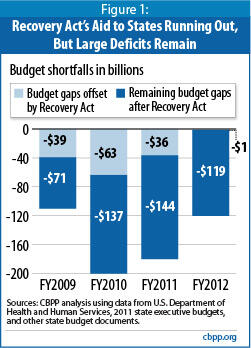- Home
- New Fiscal Year Brings More Grief For St...
New Fiscal Year Brings More Grief for State Budgets, Putting Economic Recovery at Risk
Erica Williams, Phil Oliff, Ashali Singham and Nicholas Johnson
Dismal state revenue collections caused by the severe recession are setting the stage for a new round of state budget cuts as fiscal year 2011 begins in most states on July 1. The states’ cumulative budget shortfall will likely reach $140 billion in the coming year, the largest shortfall yet in a string of huge annual gaps that date back to the beginning of the recession. Closing it will have severe effects on services and jobs.
In many states, the new fiscal year will bring immediate cuts to programs and services that are facing unprecedented demand. As of July 1, 10,000 families in Arizona will lose eligibility for temporary cash assistance; Georgia will lay off as many as 284 workers who help low-income families enroll for food stamp, Medicaid and TANF benefits; and Kansas will cut off nearly 2,800 individuals with a disability from independent living services. Education, health care, and other priority areas will also face new cuts in the coming fiscal year — on top of extensive cuts that at least 45 states have enacted over the last two years.
States are raising taxes as well for 2011. Effective July 1, Kansas and New Mexico increase their sales taxes; Hawaii, New Mexico, New York, South Carolina, and Utah increase their tax on tobacco products; Washington begins taxing soda, and Oklahoma is temporarily suspending various business and energy tax credits. Other changes have already taken effect or will take effect later in fiscal year 2011. Since 2008, more than 30 states have raised taxes or tax-like fees.
Separate and apart from dismal revenue collections, the budget situation for states just got worse. Last week, the U.S. Senate failed to pass jobs legislation that would have extended an enhanced federal match for the Medicaid program that 30 states were counting on to balance their budgets. Without these funds, states will make even deeper spending cuts and more tax increases than previously planned.
These state actions, while necessary to meet state balanced-budget requirements, will nevertheless slow the economic recovery and raise the risk that the nation will fall back into recession as the loss of Americans’ spending power ripples through the economy. States’ actions to close their $140 billion gap without more federal aid could cost the economy up to 900,000 public- and private-sector jobs.
Recession Continues to Depress Revenues

The cuts states made in response to the 2009 and 2010 shortfalls are making a slow recovery even slower. A National Association of State Budget Officers report projected that state spending for 2011 will remain 8.2 percent below 2008 levels, despite larger state populations and higher levels of need for services.[2] Newly revised Bureau of Economic Analysis data show that state and local government cutbacks sliced a half of a percentage point off GDP growth in the first quarter, cutting it from 3.2 percent to 2.7 percent. [3] States and localities (including school districts) are shedding roughly 20,000 jobs per month. The fact that the 2011 shortfalls could be even greater than the 2010 gaps suggests that this rate of job loss will continue and could even accelerate.
(The surpluses being reported by some states at the end of fiscal year 2010 can give the misleading impression that a state’s fiscal health has returned when that is not the case. End-of-year surpluses occur when revenues come in higher than the amount the state estimated when the budget was enacted or revised. The revenues available for FY2010 state budgets were far below normal levels and well below the levels needed to meet ongoing funding needs. A state that cut its budget dramatically to address the resulting shortfalls could see a positive ending balance for the year 2010 if actual revenues come in somewhat above estimates. In most states revenues will continue to fall far short of spending needs in fiscal years 2011 and beyond.)
States’ actions in response to continued shortfalls in the coming year will threaten the fragile recovery. As Mark Zandi, chief economist of Moody’s Analytics, wrote June 27 in a Philadelphia Inquirer op-ed:
Without more aid, states and cities will have no choice but to raise taxes and slash jobs and services, which could cut short the still-fragile economic recovery and trigger renewed recession. Governments would have no effective way of responding at that point, making the downturn long and painful. … At the very least, lots of jobs will be lost without more federal assistance.[4]
States Face Another Round of Painful Budget Cuts
Most states have enacted budgets for fiscal year 2011, which starts July 1 in 46 states.[5] In order to fill shortfalls caused by declining revenues, these states have relied to a large extent on reductions in spending on programs and services. Many of these cuts will have an immediate impact.
As of July 1:
- An estimated 10,000 families in Arizona will lose eligibility for temporary cash assistance as the time limit for that assistance is cut back to 36 months from 60. Over 1 million low-income Arizonans will lose access to Medicaid services offered by the state, including emergency dental services, medically necessary dentures, insulin pumps, airway devices for people with chronic lung disease, gastric bypass surgery, certain hearing aids for the deaf or severely hard of hearing, and prosthetics. Arizona also will eliminate a host of behavioral health services for 4,000 children ineligible to receive such services through Medicaid, and will eliminate case management, therapy, and transportation services for 14,500 individuals participating in a non-Medicaid program for the seriously mentally ill.
- Georgia will eliminate as many as 284 eligibility workers who help low-income families enroll in the food stamp, Medicaid and TANF programs. Eligibility workers are being cut even as an increasing number of families are qualifying these programs due to economic hardship.
- Idaho’s Department of Health and Welfare will reduce or eliminate cash assistance to 1,250 low-income elderly adults and people with disabilities.
- A Kansas reduction in grants to Centers for Independent Living will result in a loss of services for nearly 2,800 individuals with a disability.
- Minnesota residents successfully transferring from welfare to work will see monthly cash bonuses that they receive from the state cut in half (from $50 to $25).
- Oregon will make significant cuts to community mental health programs, reducing access to crisis services, acute psychiatric treatment, medications and case management services for 1,462 Oregonians with mental illness.
Other cuts to programs and services resulting from spending reductions in states’ 2011 budgets have already been implemented or will take effect later on in the new fiscal year:
- Colorado is cutting public school spending by $260 million, nearly a 5 percent decline from fiscal year 2010. The cut amounts to more than $400 per student.
- Because of changes that Connecticut made to its Medicaid program, on June 1, 2010, over 220,000 pregnant women, parents, caretaker relatives and disabled and elderly adults lost coverage for over-the-counter medications and nutritional supplements (with exceptions for insulin and supplies, nutritional supplements for those with feeding tubes, and prenatal vitamins).
- Florida’s 11 public universities will raise tuition by 15 percent for the 2010-11 academic year. This tuition hike, combined with a similar increase in 2009-10, results in a total two-year increase of 32 percent.
- Georgia is cutting state funding for K-12 education for FY 2011 by $403 million or 5.5 percent. The cut has led the state’s board of education to exempt local school districts from class size requirements to reduce costs. The state also cut state funding for public higher education. As a result, undergraduate tuition for the fall 2010 semester at Georgia’s four public research universities (Georgia State, Georgia Tech, the Medical College of Georgia, and the University of Georgia) will increase by $500 per semester, or 16 percent. Community college tuition will increase by $50 per semester.
- In Minnesota, as a result of higher education funding cuts, approximately 9,400 students will lose their state financial aid grants entirely, and the remaining state financial aid recipients will see their grants cut by 19 percent. The state is also making a 40 percent cut to state aid for counties that funds child protective services, and services provided to disabled and vulnerable adults.
- Missouri’s fiscal year 2011 budget reduces by 60 percent funding for the state’s only need-based financial aid program, which helps 42,000 students access higher education. This cut could be partially restored with other scholarship money, but will still result in a cut of at least 24 percent to need-based aid. The state is also cutting by 46 percent its funding for K-12 transportation. The cut in funding likely will lead to longer bus rides and the elimination of routes for some of the 565,000 students who rely on the school bus system.
- Mississippi’s Department of Human Services will lay off 124 workers, 115 of them from a community-based juvenile justice facility.
- Oregon is eliminating a program that helps 2,000 elderly residents who have been diagnosed with Alzheimer’s disease or a related dementia disorder to remain in their homes rather than receiving care in an institution. The state is also making major cuts to state funding for in-home care services such as meal preparation and homemaking, affecting another 10,500 elderly residents. Oregon is also cutting funding for K-12 schools, community colleges, and pre-K programs; among other results, an estimated 585 fewer children will be able to attend pre-kindergarten in the coming school year.
- Virginia’s $700 million in cuts for the coming biennium include the state’s share of an array of school district operating and capital expenses, and funding for class-size reduction in
Kindergarten through third grade.
- Washington is imposing a time limit on the receipt of medical and cash assistance by people who are physically and/or mentally incapacitated and unable to work. In 2011, the limit will reduce the number of people receiving medical assistance by 2,350 and the number of people receiving cash assistance by 2,828. The state is also cutting a further 6 percent — on top of previous years’ cuts — from direct aid to the state’s six public universities and 34 community colleges, which will lead to further tuition increases, administrative cuts, furloughs, layoffs, and other cuts. The state also cut support for college work-study by nearly one-third and suspended funding for a number of its financial aid programs.
- Wyoming is cutting aid to local areas by more than half.
New Revenue Measures in the New Fiscal Year Also Help to Fill Gaps
States can offset some of the recession-caused loss of tax revenue by increasing tax rates, broadening tax bases, repealing credits or exemptions, or taking similar measures. State tax increases that take effect on July 1 include:
- Kansas will raise its sales tax to 6.3 percent from 5.3 percent.
- Hawaii will increase its cigarette tax to $3.00 a pack from $2.60 and its tax on imported petroleum products to $1.05 a barrel from $0.05.
- New Mexico will raise its sales tax to 5.125 percent from 5 percent and its cigarette tax to $1.66 a pack from $0.91.
- New York will increase its cigarette tax to $4.35 per pack from $2.75. In New York City, the combined state and local tax per pack will rise to $5.85 from $4.25.
- Oklahoma will suspend several corporate and personal income tax credits, including a “new jobs” tax credit, credits for aerospace employers, and a credit for electric cars.
- South Carolina will raise the cigarette tax to $0.57 a pack from $0.07 per pack.
- Utah will increase the cigarette tax to $1.70 a pack from $0.70 a pack and increase other tobacco taxes.
- Washington will impose an excise tax on soda of $.02 per 12 ounces.
Other recently enacted state tax changes that will raise revenue in the new fiscal year include:
- Arizona voters approved a temporary sales tax increase to 6.6 percent from 5.5 percent, which took effect at the beginning of June.
- Colorado expanded its sales tax base earlier this spring to a number of items, including candy, soda, software, and certain energy-related items. The sales tax was applied to candy and soda as of May 1; the other expansions took effect March 1. Colorado also limited the amount of net operating loss that businesses can carry forward for the next few years, and ended a personal income tax credit for buying certain cars that run on alternative energy. Colorado also hopes to collect additional sales taxes by requiring online companies to either collect sales tax or notify customers of their sales tax obligation.
- Hawaii restored its estate tax and eliminated a tax deduction for political contributions. The renewed estate tax was applied starting May 1, and the income tax deduction will be removed starting in tax year 2011.
- Effective for tax year 2010, New Mexico eliminated an unusual provision that allowed for a deduction of state and local income taxes from the income tax calculation.
- Washington increased its business and occupation tax on services to 1.8 percent from 1.5 percent on May 1. Washington also increased its cigarette tax to $3.03 from $2.03 per pack on May 1 and on June 1, increased the beer tax, and applied the sales tax to bottled water and candy.
Additional Shortfalls Opened Up by Failure to Extend Federal Aid
States’ cumulative budget gap is likely to be larger in 2011 than it was for 2010 largely because $140 billion in emergency education and health care aid to states enacted in ARRA in February 2009 is expiring or running out. Specifically, states now have drawn down most of the funds available through the Education Department’s “State Fiscal Stabilization Fund.” And an increased match rate for the Medicaid program expires in December 2010.
Most states (about 30) assumed in their final or proposed budget for next year that Congress would extend for six months ARRA’s additional Medicaid funding because earlier this year each house of Congress passed the extension in separate bills, and the President included it in his budget proposal.
Now, Congress’ failure to act means that states that counted on the funds face gaps in their recently passed budgets. In some cases, the Governor will impose additional cuts to eliminate the new shortfall. In others, the state legislature will need to reconvene in special session to decide how to close the new fiscal gap.
The loss of funds means that:
- Alabama faces a new $197 million gap in its budget for the next fiscal year. Specifically, this gap could mean another 12.5 percent cut to the non-education part of Alabama’s budget, on top of the 12 percent cuts already made this year, for a total cut of nearly 25 percent over two years. In addition, an October 2009 expansion of a state program providing health care to 14,000 children could be wholly or partially rolled back.
- Arizona faces a new $385 million gap in its budget for the next fiscal year. The enacted budget says the state must close this gap by eliminating Medicaid for 310,000 people. Since eliminating Medicaid coverage for these people would not be allowed under the new health care reform law, Arizona would have to choose whether to flaunt the law — and lose all its federal Medicaid funding — or find other ways to cut another $385 million out of an already deeply damaged system of services, or raise that much in new revenue.
- Colorado faces another $212 million gap in its budget. The state likely will revisit cuts considered during the recent legislative session, but ultimately rejected. For instance, the legislature’s non-partisan staff suggested eliminating state aid for full-day kindergarten for 35,000 children and eliminating preschool aid for 21,000 children. The legislature also considered eliminating a free breakfast program for children at 302 low-income schools, and requiring parents of 10,164 children who receive free lunches to pay 40 cents per meal, about $144 for a family with two children, and requiring 12,926 children receiving free lunches to pay 30 cents per meal, about $108 per year for a family with two kids. In addition, the legislature considered allowing the Department of Youth Corrections to operate its facilities at 120 percent of capacity, instead of 110 percent, despite the safety risks for youth offenders. Even all of these cuts would fail to cover the gap, requiring yet more cuts or other state actions.
- Kansas faces a new shortfall of $131 million. The Governor could respond by reducing state aid for schools, as he proposed in his budget earlier this year. Such a reduction would likely result in more teacher layoffs, on top of the loss of over 450 teachers due to budget cuts in the past year.
- Maine faces a new shortfall of $85 million. As a result, the state likely will consider making cuts previously proposed but rejected, such as limiting laboratory and x-ray services, out-patient hospital visits, inpatient hospital stays, and mental health outpatient therapy. The state likely will also consider increasing co-payments for prescription drugs for some seniors and people with disabilities receiving both Medicaid and Medicare, cutting Medicaid provider reimbursement rates by up to 10 percent, and cutting domestic violence, victim assault, and family planning programs.
- Massachusetts faced a new budget gap of nearly $700 million. The loss of anticipated federal funds led the legislature to eliminate a health insurance program for low-income legal immigrants and grants for regional economic development projects. The state also imposed cuts to a wide range of other programs, including preschool funding, college scholarships, employment services, assistance for homeless families, and funding for juvenile court.
- New Mexico faces a gap of $207 million. The state could eliminate a number of Medicaid services not required by federal law, including optometry and eyeglasses, dental services and dentures, emergency hospital services, personal care assistance for the disabled, prescribed medications, inpatient psychiatric care, and hospice care. Currently, the state is considering taking these steps a year from now. Now that Congress has failed to extend the enhanced Medicaid match, New Mexico could move up the timeline. Cuts to Medicaid of this magnitude would reduce federal funding to New Mexico by an additional $500 million in matching dollars.
- Washington faces the loss of $480 million it has been counting on in its already enacted budget. Without the funds, the Governor has said she may need to call a special session of the legislature and could lay off as many as 6,000 public employees.
Other states that would have to enact additional cuts or take other measures such as tax increases to replace anticipated federal aid are Alaska, Connecticut, Florida, Georgia, Hawaii, Idaho, Illinois, Iowa, Kentucky, Missouri, New Hampshire, Nevada, Rhode Island, and Vermont, plus the District of Columbia.
End Notes
[1] See Elizabeth McNichol and Nicholas Johnson, “ Recession Continues to Batter State Budgets; State Responses Could Slow Recovery ,” Center on Budget and Policy Priorities, updated May 27, 2010.
[2] “Spring 2010 Fiscal Survey of States,” June 2010.
[3] Bureau of Economic Analysis, “Gross Domestic Product: First Quarter 2010 (Third Estimate),” June 25, 2010.
[4] http://www.philly.com/inquirer/opinion/20100627_Without_federal_help__states_remain_in_peril.html
[5] The four states whose fiscal years begin on a date other than July 1 are New York (April 1), Texas (September 1), and Alabama and Michigan (both October 1).
More from the Authors

Areas of Expertise


